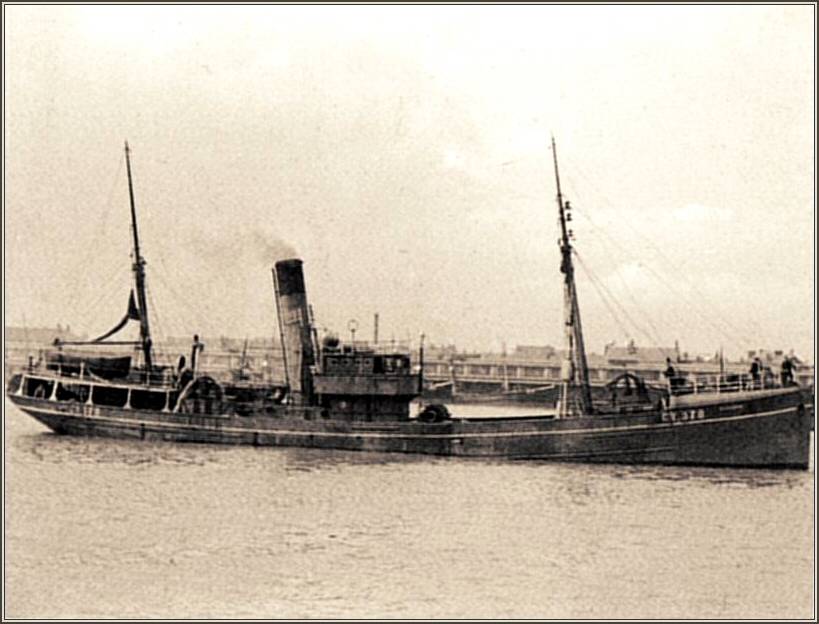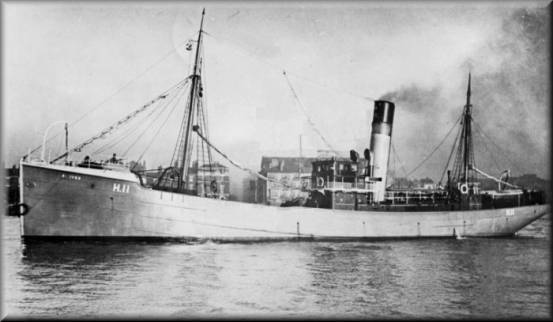News
Mark Milburn’s Cornish Wreck Ramblings, Part 5: The Trouble with Trawlers

During both the Great War and World War two, fishing trawlers, drifters and whalers were used as mine sweepers or ancillary vessels. During both wars, hundreds were put into service and many were lost. Falmouth Bay had it’s fair share. During the Great War, there were two trawlers that were lost, one due to hitting a mine, the other was lost after a collision.
On the 21st December 1916, the HMT St Ives struck a mine 2 miles WSW off St Anthony’s lighthouse, with the loss of all ten crew. The St Ives has never been found. On a dive in the area suggested by the naval report, I did find a dozen large cast iron blocks. After researching what they might be, we discarded ballast weights and cargo. As ballast, they would need to be movable, these iron blocks were roughly one ton each, not movable by the crew. As cargo, a dozen blocks weighing a ton each, wasn’t worth much, certainly not worth hiring a boat to transport them. More research into the actual vessel construction, found they could have been bow trim weights, to counteract the weight of the engine and boilers at the rear. This would be almost impossible to prove, without spending a lot of time hunting the area and still not finding any other items as proof.

HMT St Ives
The FV Tulip II collided with another vessel on 23rd August 1918, 3 miles WNW off St Anthony. There is little information available about what happened, or whether there were any casualties. The wreck has never been found. We do have a possible target area, a debris field spotted by an Olex system, half a mile from the collision location.
During WWII, there were five trawlers lost in the Falmouth area. The most confusing of these are the Sevra and AN2, it turns out they were sunk a hundred metres apart, two days apart. They both hit mines and the wreckage possibly ended up being mixed up. The Rinovia sank after hitting a mine too, it has become a popular deeper dive, lying around 50m. Lord Snowden sank in deep water after a collision with a Glasgow steamer, the Felspar. The Lord Snowden does get dived but is quite deep. The Almond hit a mine and sank in deep water in 1941, the bow and stern now lie around 200m apart. The Almond is rarely dived as it is quite deep and the two parts are so far apart.
So, in the main, the WWII trawler wrecks are in known locations. The wrecks from the Great War, are not. The trouble with the information we have is even more confusing, once we add in a discussion with a now ex diver. Within the bay there is a large oil tanker from WWII, the Caroni Rivers. Within the Caroni Rivers are the remains of a small steam vessel, thought to be a steam trawler, it could be any trawler.
The ex diver stated that in 1966, he was part of a group of divers, that removed a bronze deck gun from the trawler within the Caroni Rivers. Trawlers were not armed, except during the wars. The Caroni Rivers is around 1.5 miles from the last recorded positions of the St Ives and the Tulip II, around half way between them. There are no other trawlers missing, so what is the trawler within the Caroni Rivers? It has to be the St Ives or the Tulip II. The St Ives blew to pieces, so it is unlikely to be that. That leaves the Tulip II as the only possibility. One of the reasons I feel cautious about the Tulip II is not just the distance but the direction. Knowing the area, it is highly unlikely for the Tulip II to be blown in that direction. There is always the possibility that it tried to make it back to port, but without any confirmation of that it will remain a mystery.
Find out more about Mark and Atlantic Scuba at www.atlanticscuba.co.uk
Gear News
Introducing the TR-80, IR-50 and CS-30 Regulators from DYNAMICNORD

Whether you are a beginner or a professional diver – with the three new main regulators from DYNAMICNORD, everyone will find their favourite regulator. They all look super stylish.
Excellent performance with the TR-80
Quality and performance are the be-all and end-all for regulators. It is not for nothing that the TR stands for Tec Reg. The innovative design of the TR-80 guarantees absolute reliability – even in ice-cold waters.

Perfect breathing effort at 0.8 J/l / certified for diving in waters below 10 degrees / structural design made of solid brass for best cold protection / membrane-compensated design with dry seal of the first stage / reduced exhalation effort thanks to optimized exhalation membrane and bubble deflector / adjustable Venturi (dive/predive) and adjustment knob for individual inhalation comfort / innovative design of the front cover prevents free-flow in strong currents or when diving with scooters / design made of sandblasted brass, matt chrome finish / 2 HP and 4 LP outlets / mouthpiece made of high-quality, anti-allergic silicone for maximum comfort.


Amazing underwater adventures with the IR-50
The IR-50 is the top regulator for advanced and experienced divers. Natural breathing is the essence of this regulator.

Ideal breathing effort at 0.8 J/l /certified for diving in waters below 10 degrees / compensated membrane / adjustable venturi (dive/predive) and adjustment knob for individual inhalation comfort/ outlet valve and deflector for minimum exhalation effort and reduction of bubbles on the face / design made of sandblasted brass, matt chrome finish / 2 HP and 4 NP outlets / mouthpiece made of high-quality, anti-allergic silicone for maximum comfort.


The Workhorse – our CS-30
For diving centres and diving beginners – the workhorse stands for strong construction, reliability and robustness. Perfect for your training.

Optimal breathing effort at 0.8 J/l /recommended for diving in waters above 10 degrees / non-compensated piston / adjustable venturi (dive/predive) / outlet valve and deflector for minimum exhalation effort and reduction of bubbles on the face / design made of sandblasted brass, matt chrome finish / 1 HP and 3 NP outlets / mouthpiece made of high-quality, anti-allergic silicone for maximum comfort.


Octopus OP-30
The OP-30 is the ideal addition to all DYNAMICNORD regulators. It is identical in construction to the CS-30.

The TR-80, IR-50, CS-30 (DIN & INT) regulators and the Octopus OP-30 are available from DYNAMICNORD dealers and in the online store.
DYNAMICNORD – Your Outdoor Companion.
Marine Life & Conservation
Paul Watson Released as Denmark Blocks Japan’s Extradition Bid

Renowned anti-whaling activist Paul Watson has been released from custody in Greenland after spending five months in detention. Denmark’s Justice Ministry rejected Japan’s request for his extradition, citing insufficient guarantees that his time already served in custody would be credited against any potential sentence.
The 74-year-old Canadian-American was arrested on July 21 in Nuuk, Greenland’s capital, when his ship docked to refuel. His arrest was based on a 2012 Japanese warrant related to a 2010 encounter in Antarctic waters. Japan alleged Watson obstructed operations and caused damage to a whaling research ship during efforts to disrupt illegal whaling. Watson has consistently denied these claims, maintaining his commitment to marine conservation.
Denmark, which oversees extradition matters for Greenland, concluded that while the legal conditions for extradition were met, the lack of assurances from Japan regarding time-served credit made extradition untenable.
In a video shared by his foundation, Watson expressed gratitude and relief, saying, “After five months, it’s good to be out… and good to know they’re not sending me to Japan.” He added that the most difficult part of his time in custody was being separated from his two young sons.
Watson is a pioneering figure in marine conservation, known for founding the Captain Paul Watson Foundation in 2022 after decades of activism with the Sea Shepherd Conservation Society. His bold efforts to defend marine life have earned him widespread support, including from celebrities and conservationists. His work has also been featured in the acclaimed reality TV series Whale Wars.
Watson’s lawyer, Jonas Christoffersen, praised the decision, stating, “We are happy and relieved that Paul Watson is now free.” He added that Watson is eager to reunite with his family and continue his vital work.
The arrest occurred while Watson’s vessel, the M/Y John Paul DeJoria, was en route to the North Pacific with a team of 26 volunteers to intercept a Japanese whaling ship. His foundation described the arrest as politically motivated and emphasized that Watson’s actions were focused on ending illegal whaling practices.
Japan resumed commercial whaling in 2019 after leaving the International Whaling Commission, asserting that whale meat is a cultural tradition. Conservationists, however, continue to challenge these practices, highlighting their impact on marine ecosystems.
Despite the challenges, Watson remains steadfast in his mission to protect marine life and bring attention to whaling practices. His dedication to ocean conservation has made him a globally respected advocate for the environment.
-

 News2 months ago
News2 months agoIconic SS United States to become the World’s Largest Artificial Reef
-

 News3 months ago
News3 months agoBook Review – 52 Assignments: Underwater Photography
-

 Gear News3 months ago
Gear News3 months agoDYNAMICNORD – New German diving brand enters the British market
-

 News3 months ago
News3 months agoExploring Cenote El Pit: A Diver’s Dream
-

 Gear News3 months ago
Gear News3 months agoTry BARE drysuits (and maybe even win one!) this Friday with Sea & Sea at North West Dive Fest
-

 Marine Life & Conservation3 months ago
Marine Life & Conservation3 months agoBook Review: Coral Triangle Cameos
-

 Blogs3 months ago
Blogs3 months agoDive the Egyptian Red Sea this Autumn with Regaldive
-

 News3 months ago
News3 months ago2024 Ocean Art Underwater Photo Competition Announced















